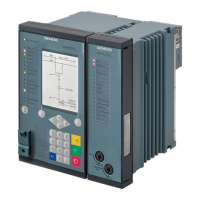B, C – – I
B
V
CA
I
C
V
AB
– –
A, C I
A
V
BC
– – I
C
V
AB
– –
A, B, Gnd I
A
V
BC
I
B
V
CA
– – I
r
V
0
B, C, Gnd – – I
B
V
CA
I
C
V
AB
I
r
V
0
A, C, Gnd I
A
V
BC
– – I
C
V
AB
I
r
V
0
A, B, C I
A
V
BC
I
B
V
CA
I
C
V
AB
– –
A, B, C, Gnd I
A
V
BC
I
B
V
CA
I
C
V
AB
I
r
V
0
Voltage Memory
Saved voltages are used if, when a 3-pole close-up fault occurs, the measuring voltages are not sufficient for
reliable direction determination. Insofar as and as long as no sufficient measuring voltage is available after the
storage time (2 s) has elapsed, the detected direction is retained. If the memory does not contain any voltages
(when closing onto a short circuit, for example), the behavior of the stage is defined using the Non-direc-
tional pickup parameter.
Direction Determination
As mentioned in the General section, the direction is determined by calculating the phase angle between
short-circuit current and reference voltage. To take different system conditions and applications into account,
the reference voltage can be rotated through an adjustable angle (Rotation angle of ref. volt.
parameter). This moves the vector of the rotated reference voltage close to the vector of the short-circuit
current. Consequently, the result of direction determination is as reliable as possible. Figure 7-98 illustrates
the relationship based on a 1-phase ground fault in phase A. The short-circuit current I
scA
lags the short-circuit
voltage by the short-circuit angle φ
sc
. The reference voltage, in this case V
BC
for measuring element A, is
rotated positively (counterclockwise) by the setting value of the Rotation angle of ref. volt. param-
eter. In the scenario illustrated here, the rotation is +45
o
.
[dwdocp33-070611-01.tif, 2, en_US]
Figure 7-98 Rotation of the Reference Voltage, Phase-Measuring Element
The rotated reference voltage defines the forward and reverse range, as shown in Figure 7-99. The forward
range is calculated as ±88
o
around the rotated reference voltage V
ref,rot
. If the short-circuit current vector is
located in this range, the device decides on the forward direction. In the mirrored range, the device decides on
the backward direction. In the intermediate range, the direction is undetermined.
Protection and Automation Functions
7.6 Directional Overcurrent Protection, Phases
SIPROTEC 5, High-Voltage Bay Controller, Manual 695
C53000-G5040-C015-9, Edition 11.2017

